Real-time 3D results and analysis graphics and Brainstorm virtual set.
The VR studio
This was Jeremy Vine’s first outing as BBC Election analysis guru (Peter Snow had retired from Elections following the General Election of 2005). A simple but convincing VR set served as a solid grounding for the graphics – something that would provide a neutral backdrop for Jeremy and tie in seamlessly with the main Millbank studio.
We photographed the Millbank set and made a full set of textures and lighting effects, and applied them to the model I’d built in Maya. Compare the two images below – on the left the real studio. The VR set is on the right.
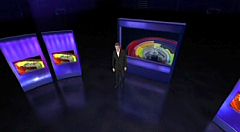
Jeremy Vine in the VR environment
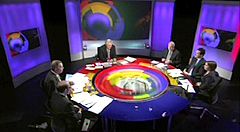
the main (real) studio
We wanted to keep the studio dark, so I opened up the panels allowing more dark-space available as a background for the graphics. I was also keen to put in as much of the ‘polish’ first, as the fine-tuning of textures behind graphics is often the last thing that deadlines permit. I was determined to put in the hours to get the set looking convincing as a real studio space at the start of the project, so quite a bit of time was spent on the textures, including soft reflections in the studio floor.
The VR studio
I wanted to make a clear distinction between the 3D graphic elements that constituted the ‘set’ or background, and the graphic elements that conveyed information or content. So the VR set itself was grounded in reality, but the content graphics were designed with a ‘holographic’ feel – as if they were built out of light. I built a set of animating ‘beams’ and these were used to illuminate the graphics as they appeared, as if the graphics were being projected from somewhere off-screen.
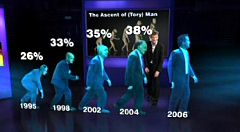
Jeremy Vine and ‘the Ascent of Tory Man’
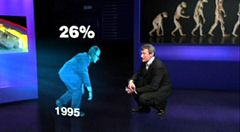
Jeremy Vine and ‘the Ascent of Tory Man’
Each of the ‘projected’ graphics had a certain amount of degradation applied to the texture sequences to give the graphics a sense of slight flickering and video noise. This concept was taken further in the ‘Labour Reception’ graphic where we intentionally degraded the image of Tony Blair in the screen to match the idea of ‘losing reception’ with the electorate.
Histograms
The video ‘noise’ idea was followed through with the histograms. They also had a shimmer to them, as well as a few textures placed here and there to simulate a glow effect.
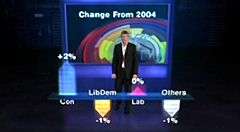
Histograms
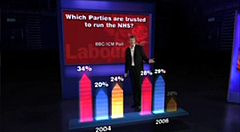
Histograms
These graphics were all real-time rendered so consequently we needed to keep an eye on the various overheads – for this reason the texture image sequences needed to be very short, but still giving the illusion of slow moving pulses.
Maps
Budget limitations meant that the map needed to be kept simple – no database of results, or colouring up individual vector-based regions. In keeping with the night-time feel of the show, and the concept of the information being revealed or driven by ‘light’ I decided to produce something that suggested a night-time satellite image of the UK, with the council buildings represented by different coloured spotlights. This meant we could just provide a set of co-ordinates and simple cutout to mark each council.
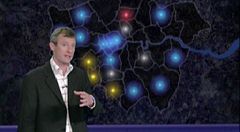
London results map
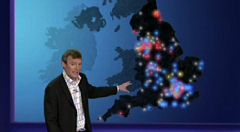
England results map
The VR ‘screen’
We made good use of the screen behind Jeremy (which of course didn’t exist for real in the limited space in the Millbank Newsroom which we were using as a temporary VR studio). The map textures were of a high enough resolution to allow the virtual camera to take close-ups of the screen without the image degrading.
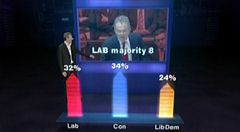
Histograms and VR screen
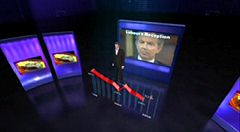
Line graph
We also used the screen for background images to sit behind the ‘DIY’ histogram graphics, as well as the space to locate the titles of each graphic. And as Jeremy stood between the screen and the foreground graphics, we were able to get a nice sense of space and depth for his VR sequences, especially those that used multiple camera angles within a single graphic.
Further information
- Silver award winner at the BDA World Gold Finals 2007
- See also : VR studio set design for Setanta Sports